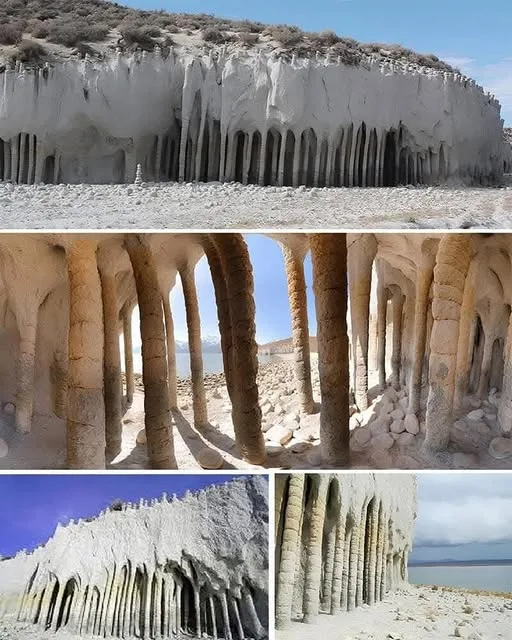Tucked along the shores of Crowley Lake in California’s Eastern Sierra, a striking geological phenomenon captivates visitors and scientists alike: the Crowley Lake stone columns. These towering, intricately patterned pillars, resembling something from an alien landscape, were born from a catastrophic volcanic eruption over 760,000 years ago. Uncovered by erosion and studied in detail by geologists in 2015, their formation reveals a remarkable interplay of heat, water, and time. Let’s explore the origins, science, and wonder of these natural sculptures that stand as a testament to Earth’s creative forces.

A Volcanic Genesis
The story of the Crowley Lake columns begins with a massive eruption around 760,000 years ago, when the Long Valley Caldera unleashed a colossal explosion, blanketing the region with hot volcanic ash, or tuff. This ash, deposited in thick layers, set the stage for an extraordinary geological process. As the ash cooled but remained hot, seasonal snowmelt from the surrounding Sierra Nevada mountains seeped into the porous material. The interaction between cold water and hot ash triggered a unique chemical and physical reaction, giving rise to the columns.
The Science of Formation: Convection Cells and Mineral Magic
In 2015, geologists from the University of California, Berkeley, led by Noah Randolph-Flagg, unraveled the mystery of the columns’ formation. Their research revealed that when cold snowmelt infiltrated the still-hot volcanic tuff, it created tiny holes where water boiled and steam escaped. These conditions sparked the formation of convection cells—small, self-organized pockets of circulating hot water and steam within the ash.
Over time, these convection cells acted like natural kilns, concentrating minerals carried by the water. The minerals—primarily silica and other compounds—precipitated and hardened within the cells, forming structures more resistant to erosion than the surrounding tuff. As wind, water, and waves from Crowley Lake eroded the softer ash over millennia, the hardened columns emerged, standing like sentinels along the lake’s edge.
A Gallery of Natural Pillars
The Crowley Lake stone columns are a sight to behold. Ranging from 5 to 20 feet tall and up to 2 feet in diameter, they number around 5,000, scattered across the lake’s northern and eastern shores. Their surfaces are adorned with intricate, honeycomb-like patterns, a remnant of the convection cells’ structure. Some columns are freestanding, while others remain partially embedded in the tuff, creating a surreal landscape that evokes ancient ruins or modernist sculptures.
The columns vary in shape—some are cylindrical, others slightly tapered or twisted, reflecting the dynamic conditions of their formation. Their grayish-white hues contrast with the surrounding landscape, and their exposed surfaces, polished by erosion, reveal the delicate interplay of mineral deposits and volcanic ash.
A Geological Time Capsule
The Crowley Lake columns are more than a visual spectacle; they’re a window into Earth’s geological past. The Long Valley Caldera eruption, one of the largest in North America’s history, produced the Bishop Tuff, a layer of volcanic ash stretching across much of eastern California. The columns’ formation within this tuff highlights the power of hydrothermal processes, where heat and water collaborate to create enduring structures. Their resistance to erosion, compared to the softer surrounding material, underscores the selective durability of mineralized rock—a natural lesson in patience and persistence.
The 2015 study also drew parallels between the Crowley Lake columns and similar formations elsewhere, such as the “fossil geysers” in Yellowstone or hydrothermal vents on the ocean floor. These comparisons suggest that convection-driven mineralization is a universal process, shaping landscapes across diverse environments.
A Hidden Wonder Revealed
The columns remained largely unknown until Crowley Lake, a reservoir created in 1941, began eroding the surrounding tuff, exposing the pillars to view. Their full significance came to light with the 2015 geological study, which used chemical analysis and 3D modeling to confirm the convection-cell hypothesis. Today, the columns are accessible to visitors, though their remote location—about 15 miles south of Mammoth Lakes—keeps them a hidden gem. Hiking or boating to the site offers a chance to witness this natural gallery, but visitors are urged to tread lightly to preserve the fragile formations.
Why the Crowley Lake Columns Matter
The Crowley Lake stone columns are a testament to the beauty and complexity of geological processes. Born from a violent eruption and sculpted by the slow dance of water and minerals, they remind us of Earth’s ability to create art from chaos. Their discovery not only deepens our understanding of volcanic landscapes but also sparks wonder at the hidden forces shaping our planet. For geologists, hikers, and curious travelers, these pillars stand as a natural monument, inviting us to marvel at the intricate interplay of time, heat, and erosion that crafted this extraordinary corner of California.





